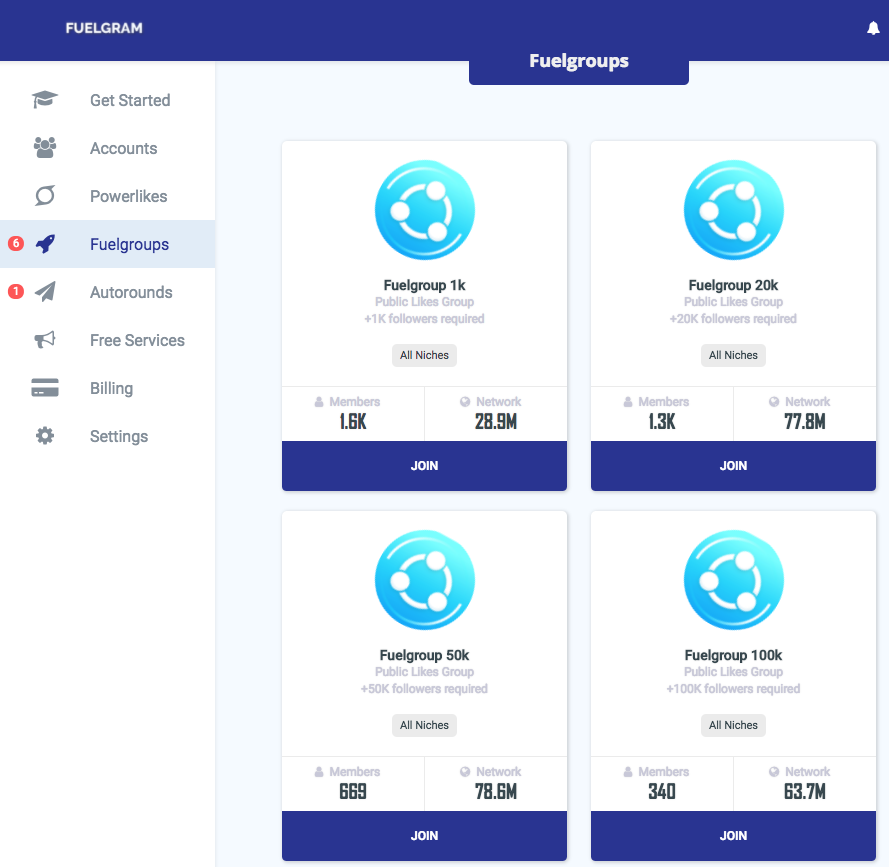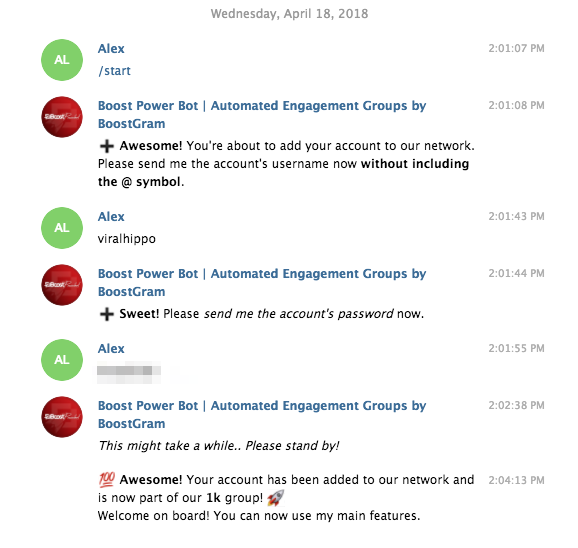In late February, an Instagram account called Viral Hippo posted a photo of a black square. There was nothing special about the photo, or the square, and certainly not the account that posted it. And yet within 24 hours, it amassed over 1,500 likes from a group that included a verified model followed by 296,000 people, a verified influencer followed by 228,000, a bunch of fitness coaches, some travel accounts, and various small businesses. “I really love this photo,” one commented.
The commenter wasn’t a bot; nor were any of the accounts that liked the black square. But their interest in it wasn’t genuine. These were real people, but not real likes — none of them clicked on the like button themselves. Instead, they used a paid service that automatically likes and comments on other posts for them. Instagram says this is against its terms of service, but it continues to operate. It's called Fuelgram and, for a few dollars a month and access to your Instagram log-in credentials, it will use the accounts of everyone who paid that sum to like and comment on your posts — and it will use yours to do the same to theirs.
In other words, Fuelgram creates fake engagement from real Instagram accounts. And it's quite effective. Fuelgram makes posts appear more popular than they are, tricking Instagram's algorithm into spreading them further, sometimes right into the service's high-profile Explore tab. And there's a reasonable chance there's one in your feed right now, because Fuelgram is just one of a number of Instagram-juicing services available today, and the photo-sharing platform's engagement-rewarding algorithm incentivizes people to use it.

“Fuelgram is an amazing tool for bloggers like me,” Eliza Armand, a fashion blogger followed by 86,000 people, told BuzzFeed News.
Amazing indeed. Viral Hippo, the BuzzFeed News–created Instagram account that used Fuelgram to rack up more than 1,500 likes on a photo of a black square, netted almost double that on a photo of a yellow square. It pulled in 1,400 likes on a diagram of the human sinus, and more than 1,200 on an accidentally shot photo of a hubcap. The likes were from real accounts.
"It’s not just Russian bots and hackers, it’s 22-year-old kids in their dorm rooms and influencers and brands of all sizes."
For Armand and others like her, the additional Instagram exposure Fuelgram provides can be quite valuable. It can mean more ad dollars, or a shot at a modeling contract or a gig, or more inquiries for a business. And as Instagram has increased in popularity, Fuelgram and other similar services — including automated engagement trading groups on the secure messaging app Telegram and Facebook itself — have become must-haves for many looking to build a business or gain exposure on the internet.
Brands like Walmart, Kroger, and the skin treatment product Aquaphor showed up in sponsored, Fuelgram-juiced posts BuzzFeed News uncovered. Multiple Fuelgram users who liked Viral Hippo’s intentionally terrible posts liked these posts as well. The sponsored posts, an industry insider told BuzzFeed News, can fetch anywhere from $500 to $3,000 a pop. Walmart did not respond to requests for comment. Kroger did not comment. Aquaphor spokesperson Leslie Kickham told BuzzFeed News the company has severed its relationship with the Instagram influencer that was promoting its products.
“Fraudulent activity is bad for everyone. We have a strong incentive to prevent this kind of behavior on Instagram and staff a number of teams to detect fraudulent activity and shut it down,” Instagram spokesperson Gabe Madway told BuzzFeed News.
Asked if Instagram will disable Fuelgram, Madway declined to comment.
It is not at all that clear the people contacted for this story knew Instagram viewed Fuelgram as an enabler of fraudulent activity.
A Bot Factory In Your Palm

Sitting in his small, lofted bedroom in San Francisco’s Potrero Hill neighborhood, Kent Heckel picked up a palm-sized computer off a ledge next to his bed and explained how it’s home to more than 2,900 Instagram bots. The computer, called a Raspberry Pi, is a $35 hobby machine designed for students, teachers, and tinkerers. For Heckel, it’s been something else: a bot farm, delivering a stream of US-based likes to his Instagram account and the accounts of five paying clients.
Heckel’s bot farm is not a complex operation. He uses the Raspberry Pi to run a script that checks his and his clients’ accounts every few seconds. When the script sees a new post, it logs into each of the 2,900 accounts it controls and uses them to like it. The script can automate up to three likes per second. It pulls the bots’ usernames and passwords from a spreadsheet Heckel bought access to on Telegram’s Black Market group for approximately $1,600 last year. For Heckel, the bot and Fuelgram come together masterfully. In April alone, he’s used them to make $12,000.
Heckel has no reservations about gaming Instagram — and no regrets, either. For him, the platform's failure to protect itself from manipulation has established an uneven playing field just asking to be exploited. “It’s not just Russian bots and hackers, it’s 22-year-old kids in their dorm rooms and influencers and brands of all sizes,” he said. “The damage is done on a very large level because nothing is genuine.”
"The products people are pushing to you are inauthentic and most of the comments under them are fake. That’s not the system that we want to live in."
Renee DiResta, policy lead at Data for Democracy, believes this level of manipulation is deeply corrosive. “The risk of realizing that the internet is massively manipulated is that the cognitive overhead to process even the most basic interactions increases, suspicion increases, polarization potentially increases,” she told BuzzFeed News. “The engagement is fundamentally manipulated; the content you’re seeing, you’re seeing because someone gamed an algorithm; the products people are pushing to you are inauthentic and most of the comments under them are fake. That’s not the system that we want to live in.”
Fuelgram’s most useful services are called Autorounds and Fuelgroups; entry to each requires handing over your username and password. To participate in an Autoround, you input your log-in details into Fuelgram, pay around $15, and post at designated times of the day. Each time you post, hundreds of fellow Autoround participants like your post, and your account likes their posts back.
Reached for comment, Fuelgram’s proprietors insisted their service was legitimate and not a violation of Instagram policy. They claimed that the engagement they deliver is not entirely automated, and their algorithms push the posts to a sea of thousands of human likers across the world.
Heckel said he's dubious of such claims. “If they are actually doing it by hand my mind will be blown,” he said. “They send 10,000s of likes a second.”

Fuelgroups deliver torrents of likes, and a healthy number of comments, whenever you post on Instagram. A minimum of 1,000 followers is required to join the most basic Fuelgroup, and there’s one open to accounts with above 500,000, indicating a healthy market for very influential accounts.
@Photo is one Instagram account that’s made it into the 100,000-plus Fuelgroup. It’s owned by Heckel, who claims it makes hundreds of dollars a week via paid mentions. @Photo is followed by some 124,000 people, and according to Heckel it owes almost all its success to Fuelgram and similar services. “The bots definitely work,” Heckel said. “@Photo went from zero followers to 100K in less than six months. Bots were instrumental in that growth.”
Heckel’s not kidding. The bots really do work. The Instagram account we created for this story made it into the 1,000-plus-follower Fuelgroup within two days after being juiced by approximately $15 dollars worth of fake followers, fake likes, and fake comments. Once our “Viral Hippo” account was admitted to the group, likes from popular accounts poured into our posts the moment they were shared, reaching into the hundreds within minutes. Comments followed soon after, enthusiastically praising the posts no matter what they contained.
Instagram’s algorithms use comments and likes as key signals when deciding which posts to place at the top of your feed and its discovery-focused Explore page — and Fuelgram’s likes and comments helped Viral Hippo reach a broad audience beyond those who followed the account. Two screenshots of viral tweets were liked by more than 4,000 people, compared to the baseline of 1,500 likes for the all-black square.
Boost Power Bot drove hundreds of likes to a stock image of a steaming manure pile.
Via Fuelgram, Viral Hippo also liked and commented on an endless stream of posts — posts from doctors, lawyers, professional influencers, self-proclaimed venture capitalists, models, fitness gurus, marketing agencies, and even a few baby accounts. It liked hundreds of posts per day.
Cade Ellis, an 18-year-old rapper, told BuzzFeed News he was using Fuelgram to expand his reach and break out of geographic isolation in North Florida. “Social media is very important to get out there; I have to use it,” he said. “Fuelgram is a cool service. It helps you look good and establish yourself.”
Photographer Reilly Small echoed that sentiment, noting that Instagram’s algorithm had negatively impacted his reach in a way that forced him to get creative. “Software like Fuelgram is necessary,” he said. “I love Instagram, but because they meddled in this kind of way, I think that it is pushing a lot of influencers and businesses to look for other ways to grow.”
On Telegram, engagement trading occurs in the open. The messaging app — currently battling Russian government attempts to shut it down over its unwillingness to hand over its encryption keys — is home to groups with names like Black Market, RasieFluence, and BoostGram, whose entire purpose is to game Instagram. Share your account credentials with a chatbot called Boost Power Bot, found via the BoostGram group, and your posts will get engagement “within minutes,” the service’s promotional video promises. “It’s that simple!” two women declare at the end of the video. The two women in the video weren’t lying. Boost Power Bot drove hundreds of likes to a stock image of a steaming manure pile posted to Viral Hippo.

There are similar engagement gaming communities on Facebook Groups. The 17,000-member “Instagram Engagement Group” posts “daily like threads,” where members comment with their username and link to a post they want members of the group to like. Then, using a browser plug-in called “LikeItAll,” group members like every post in the thread automatically. LikeItAll’s web page boasts of more than 127 million posts “autoliked.” Facebook shut down the Instagram Engagement Group on Thursday after being contacted by BuzzFeed News.
The reciprocal nature of these services makes it easy to determine who’s using them. “How did you find out that I'm using Fuelgram?” Armand asked. Answer: Her popular account had liked a completely gray square posted by Viral Hippo. She wasn’t particularly concerned though; to Armand, gaming Instagram is so commonplace, it’s unremarkable.
Given the incentives created by Instagram, Heckel and his fellow Fuelgram users feel like they have a simple choice: post to Instagram, pray for engagement and risk not getting any; or do whatever you can to amass likes and comments to get your profile, business, or political view in front of the platform’s 800 million users. Heckel has made his decision. If Instagram can’t stop people from gaming its algorithm, he’s going to game it. And should Instagram shut down services like Fuelgram, he anticipates more will rise in their place. “There will always be a next thing, a next bot … something in the pipeline in the Telegram groups,” Heckel said. “Just so you know — and you can quote me on this — I don't plan on stopping.”
